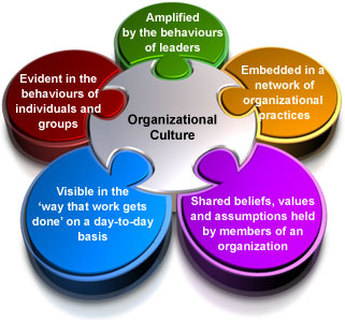2.5 Organizational and corporate cultures
What will study?

- Define the meaning of organizational (or corporate) culture
- Outline elements of organizational culture
- Outline types of organizational culture
- Discuss the reasons for, and consequences of, cultural clashes within organizations when they grow, merge when leadership styles change
- Explain how individuals influence organizational culture and how organizational culture influences individuals.
The way we do things around here.....
The corporate culture is 'the way things are done'. It is what differentiates one company from another. Look at Japanese firms where all directors, managers and staff tend to eat together, rather than the old UK system of multi-layers of restaurants and canteens, the use of which is based on seniority. These examples illustrate different corporate cultures. The corporate culture will influence:
So, the corporate culture decides such essentials as:
Culture can affect such diverse things as:
Culture Gap
The difference between the culture wanted and what it actually is. It is important to efficiency and morale that everybody knows what the firm is trying to do, and how it is trying to do it. Staff must know what the corporate culture is, and work towards achieving it. There are immediate problems here - communications. Language use and skills are different between different levels of the firm, and between different regions, if not countries. This gives problems when trying to develop or change corporate culture. One way used to try and develop corporate culture is the mission statement
- The way the business is managed
- How decisions are made
- The type of decisions that are made and in what priority
- The relationships the business has with its stakeholders
- The way a firm judges its successes
So, the corporate culture decides such essentials as:
- The norms considered acceptable within a business
- How people are expected to behave, dress and conduct themselves within the business
- Routines
- Which aspects of personality and characteristics are considered to be 'good' and which are not
- The rules of the organization
Culture can affect such diverse things as:
- motivation strategies used
- customer service
- innovation
- react to change
- efficiency and productivity
Culture Gap
The difference between the culture wanted and what it actually is. It is important to efficiency and morale that everybody knows what the firm is trying to do, and how it is trying to do it. Staff must know what the corporate culture is, and work towards achieving it. There are immediate problems here - communications. Language use and skills are different between different levels of the firm, and between different regions, if not countries. This gives problems when trying to develop or change corporate culture. One way used to try and develop corporate culture is the mission statement
What is Seisen's culture?
Organizational or corporate culture:
The values, attitudes and beliefs of the people working in an organization that control the way they interact with each other and with external stakeholder groups.
The values, attitudes and beliefs of the people working in an organization that control the way they interact with each other and with external stakeholder groups.
A great corporate culture |
An awful corporate culture |


